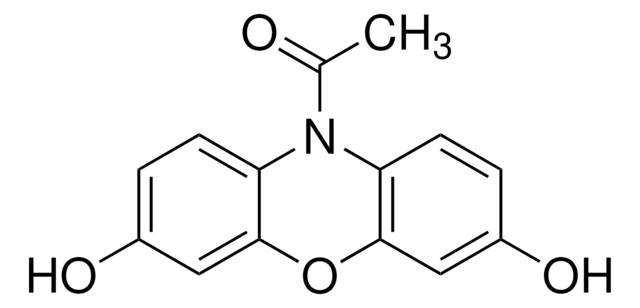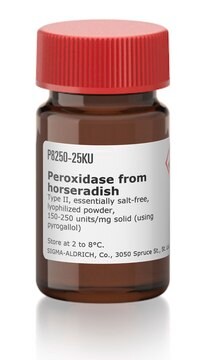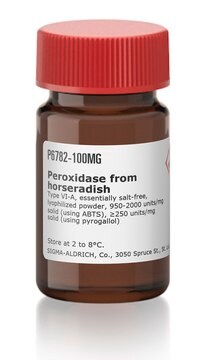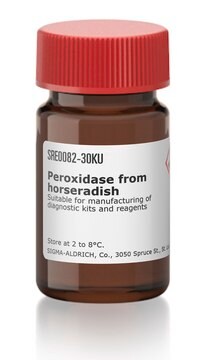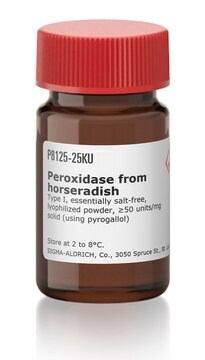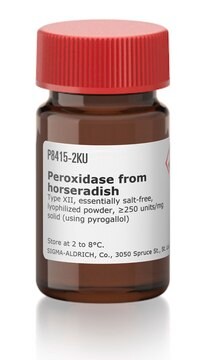Wszystkie zdjęcia(1)
Key Documents
10108090001
Roche
Peroxidase (POD)
grade I, from horseradish
Synonim(y):
POD, peroxidase
Zaloguj sięWyświetlanie cen organizacyjnych i kontraktowych
About This Item
Polecane produkty
pochodzenie biologiczne
horseradish
Poziom jakości
Postać
lyophilized (salt-free)
aktywność właściwa
≥250 units/mg protein (At 25 °C with guaiacol and H2O2 as the substrates.)
250 U/mg
opakowanie
pkg of 25,000 U
producent / nazwa handlowa
Roche
optymalne pH
6.0-6.5
Warunki transportu
wet ice
temp. przechowywania
2-8°C
Powiązane kategorie
Opis ogólny
Donor:hydrogen-peroxide oxidoreductase
Peroxidase (POD) (E.C. 1.11.1.7) is extensively expressed in most fruits and vegetables.
Zastosowanie
Oxidation of electron donors (e.g., epoxidation of double bonds). Peroxidase can be coupled to other proteins via its amino groups, as well as its carbohydrate moiety. The reconstituted solution can be used directly for conjugation without prior dialysis.It has been used in ligand blotting.
Peroxidase (POD) has been used in AUR (Amplex UltraRed assay) to measure extracellular H2O2 produced from disaggregated slug cells.
Działania biochem./fizjol.
Peroxidase (POD) is involved in the dehydrogenation of a large number of organic compounds including, phenols and aromatic amines, hydroquinones and hydroquinoid amines, mainly benzidine derivatives.
Jakość
Contaminants: <0.001% ATPase and acid phosphatase each, <0.7% catalase
Purity number: approximately 3.0 (A403/A275)
Purity number: approximately 3.0 (A403/A275)
Uwaga dotycząca przygotowania
Activator: Ammonia, pyridine, imidazole, all at pH >7; detergents.
Working solution: PBS (phosphate buffered saline) or water (starting concentration 20 mg/ml).
Working solution: PBS (phosphate buffered saline) or water (starting concentration 20 mg/ml).
Rekonstytucja
Solution (10 mg/ml in water): clear, red brown; pH-value: 6.0 to 7.0.
Inne uwagi
For life science research only. Not for use in diagnostic procedures.
This page may contain text that has been machine translated.
Hasło ostrzegawcze
Danger
Zwroty wskazujące rodzaj zagrożenia
Zwroty wskazujące środki ostrożności
Klasyfikacja zagrożeń
Resp. Sens. 1 - Skin Sens. 1
Kod klasy składowania
11 - Combustible Solids
Klasa zagrożenia wodnego (WGK)
WGK 1
Temperatura zapłonu (°F)
Not applicable
Temperatura zapłonu (°C)
Not applicable
Certyfikaty analizy (CoA)
Poszukaj Certyfikaty analizy (CoA), wpisując numer partii/serii produktów. Numery serii i partii można znaleźć na etykiecie produktu po słowach „seria” lub „partia”.
Masz już ten produkt?
Dokumenty związane z niedawno zakupionymi produktami zostały zamieszczone w Bibliotece dokumentów.
Klienci oglądali również te produkty
Methods of Enzymatic Analysis (1974)
Social amoebae trap and kill bacteria by casting DNA nets
Zhang X, et al.
Nature Communications, 7, 10938-10938 (2016)
Inactivation and conformational change of horseradish peroxidase induced by pulsed electric field
Zhong K, et al.
Food Chemistry, 92(3), 473-479 (2005)
Mi Kyong Lee et al.
Applied and environmental microbiology, 69(8), 4648-4657 (2003-08-07)
The Vip3A protein, secreted by Bacillus spp. during the vegetative stage of growth, represents a new family of insecticidal proteins. In our investigation of the mode of action of Vip3A, the 88-kDa Vip3A full-length toxin (Vip3A-F) was proteolytically activated to
Xuezhi Zhang et al.
Nature communications, 7, 10938-10938 (2016-03-02)
Extracellular traps (ETs) from neutrophils are reticulated nets of DNA decorated with anti-microbial granules, and are capable of trapping and killing extracellular pathogens. Various phagocytes of mammals and invertebrates produce ETs, however, the evolutionary history of this DNA-based host defence
Nasz zespół naukowców ma doświadczenie we wszystkich obszarach badań, w tym w naukach przyrodniczych, materiałoznawstwie, syntezie chemicznej, chromatografii, analityce i wielu innych dziedzinach.
Skontaktuj się z zespołem ds. pomocy technicznej


